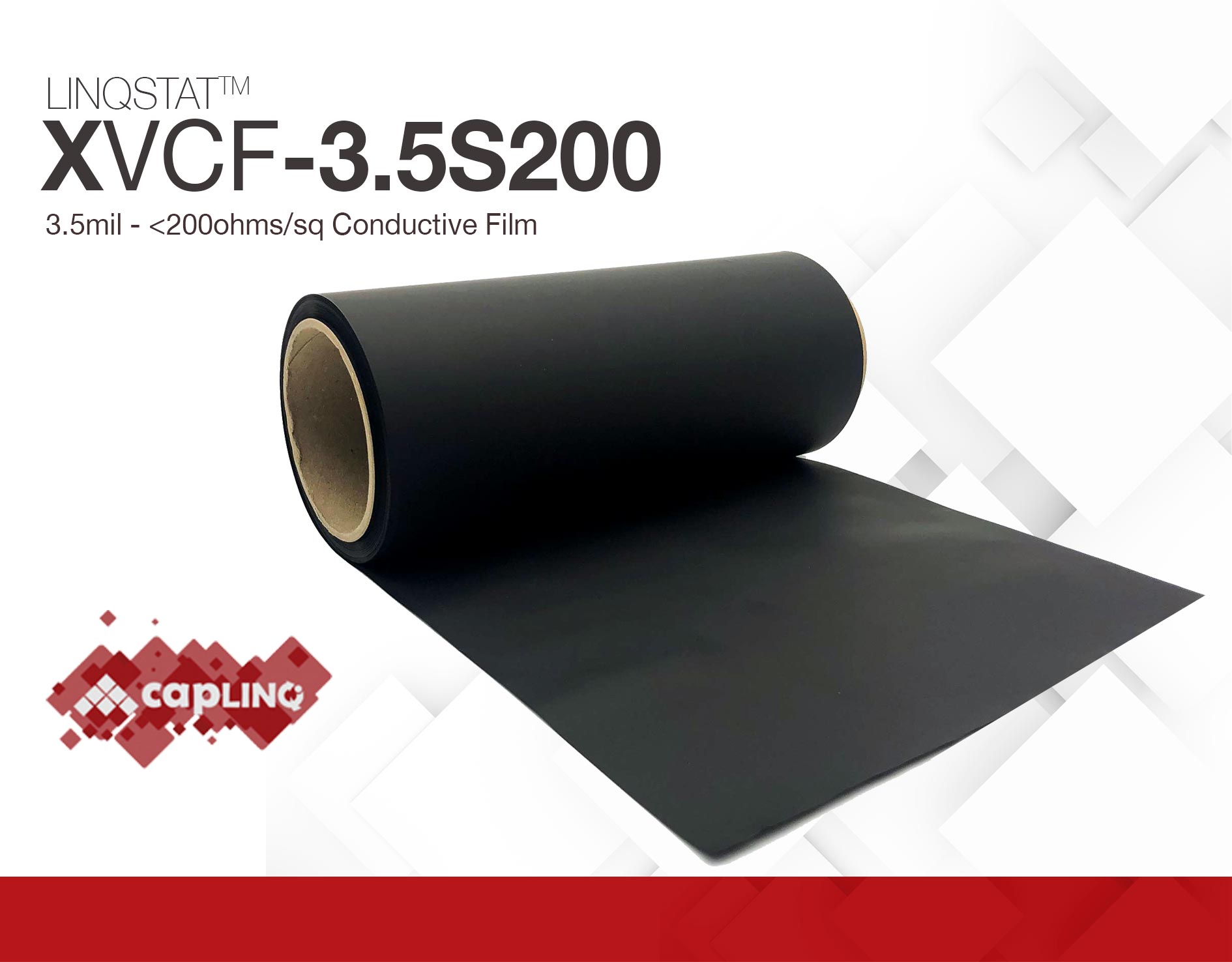XVCF-3.5S200 | LINQSTAT 3.5 mil - 200 Ω/sq Conductive Film
- 3.5 mil - 89um - 0.09mm
- ±200 Ohms/sq Surface resistivity
- ±25 ohms-cm Volume resistivity
Product Description
LINQSTAT XVCF-3.5S200 is a highly conductive conductive polyethylene film with a very high electrically conductive carbon loading and a very dense polymer mix. Using a premium polymer and a refined process, we are able to increase the conductivity and thus reduce the surface resistance of the plastic to as low as ±200 ohms/sq of surface resistance. This extra loading allows the film to be used in applications that require a lower resistivity. Volume resistivity, based on the thickness of the material is around 25 ohms-cm.
XVCF-3.5S200 conductive films are thin (0.09mm or 3.5 mil), lightweight and relatively inert. Furthermore, they are well suited for applications requiring electrochemical reactions, high conductivity or charge storage including but not limited to electrodes (ECG, TENS, Defibrillation and Iontophoresis), batteries (flat-cell zinc/manganese dioxide (MnO2), Lithium Ion and Lithium polymer), wearable electronics and digital whiteboards.
XVCF-3.5S200 film and its conductivity are unaffected by humidity and age. The film is heat sealable, flexible and offers exceptional abrasion resistance. The film gives good thermal stability and has outstanding chemical resistance. It has a standard thickness of 89µm (3.5 mil) and is available in various lengths and widths upon request. This is one of the most conductive plastic films in our entire product line. Additionally, the film has been proven to be highly UV resistant, absorbing UV radiation at 365 nm up to 100%. If you need lower resistivity the Polyethylene carbon loaded films have pretty much reached their limits. You might want to consider Polyurethane films that can go down to 10 ohms/sq.
Technical Specifications
| General Properties | |||||||||||||
| Chemistry Type | Carbon-Loaded PE | ||||||||||||
| Color Color The color | Black | ||||||||||||
| Film Thickness | 0.09 mm | ||||||||||||
| Specific Gravity Specific Gravity Specific gravity (SG) is the ratio of the density of a substance to the density of a reference substance; equivalently, it is the ratio of the mass of a substance to the mass of a reference substance for the same given volume. For liquids, the reference substance is almost always water (1), while for gases, it is air (1.18) at room temperature. Specific gravity is unitless. | 1.16 | ||||||||||||
| Chemical Properties | |||||||||||||
| Water Absorption | 0.53 % | ||||||||||||
| Mechanical Properties | |||||||||||||
| Elongation Elongation Elongation is the process of lengthening something. It is a percentage that measures the initial, unstressed, length compared to the length of the material right before it breaks. It is commonly referred to as Ultimate Elongation or Tensile Elongation at break. | 7.3 % | ||||||||||||
| |||||||||||||
| Electrical Properties | |||||||||||||
| Surface Resistivity | 200 Ohms/sq | ||||||||||||
| Thermal Properties | |||||||||||||
| |||||||||||||
| Thermal Conductivity Thermal Conductivity Thermal conductivity describes the ability of a material to conduct heat. It is required by power packages in order to dissipate heat and maintain stable electrical performance. Thermal conductivity units are [W/(m K)] in the SI system and [Btu/(hr ft °F)] in the Imperial system. | 0.053 W/m.K | ||||||||||||
| Other Properties | |||||||||||||
| RoHS Compliant RoHS Compliant RoHS is a product level compliance based on a European Union Directive which restricts the Use of certain Hazardous Substances in Electrical and Electronic Equipment (RoHS). Products compliant with this directive do not exceed the allowable amounts of the following restricted materials: lead, mercury, cadmium, hexavalent chromium, polybrominated biphenyls (PBB) and polybrominated diphenyl ethers (PBDE), with some limited exemptions | Yes | ||||||||||||
Additional Information
Dimensional Tolerances:
Thickness: 0.11 ±0.01mm,
Width: 30cm ±2mm,
Length: 46m ±m.
Given its low surface resistance, LINQSTAT XVCF films have been successfully used as a pressure sensor making them useful for applications that require more conductivity to be able to detect more subtle pressure differences.
Applications:
- ECG electrodes
- TENS electrodes
- Defibrillation electrodes
- Digital white boards
- Lithium ion / polymer battery
- Flat-cell MnO2 battery
Due to its low-resistivity and its resistance to a range of chemicals and alcohols, these films are suitable for use in electrodes. Their matte finish allows them to be printed on, and the low material thickness makes them flexible to adapt well to a range of contours.
Chemical Susceptibility:
- Methanol: Resistant
- Ethanol: Resistant
- Isopropanol: Resistant
- Weak Acids: Resistant
- Ketones (Acetone): Slow Attack
- Weak Alkalines: Slow Attack
- Hydrocarbons: Non-Resistant
Product Features & Benefits:
- Volume-conductive plastic
- Black Opaque - Printable
- Provides Anti-Static protection to electronics components
- Groundable
- Humidity independent conductivity
- Thin, Lightweight, Inert
These films have a higher carbon loading than our standard VCF-Series films. This higher carbon loading gives us a lower resistance and as such, a higher conductivity. We come to a physical limit on how much carbon this plastic can be loaded before other properties are adversely affected, and so to get even more conductivity, we need to go to a more dense polymer matrix as we have done with our XVCF-ALS series films. The result of this denser matrix is a higher conductivity and better mechanical properties.
We have recently changed our SKUS. To help you search for them either on google or on our website here's a before and after table. As you can see we went for the "Product codes that make sense" approach:
| XVCF-35009BT200S/4A | XVCF-3.5S200/23CM-500M | 23cm wide x 500m long |
| XVCF-35012BT200S/2A | XVCF-35012BT200S/2A | 30cm wide x 46m long |
| XVCF-35012BT200S/4A | XVCF-3.5S200/30CM-500M | 30cm wide x 500m long |
| XVCF-35013BT200S/4A | XVCF-3.5S200/32CM-500M | 32cm wide x 500m long |







